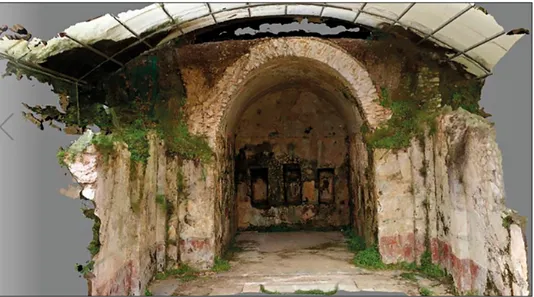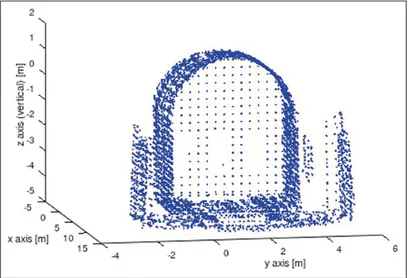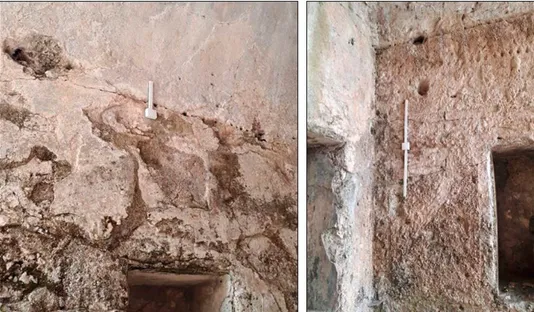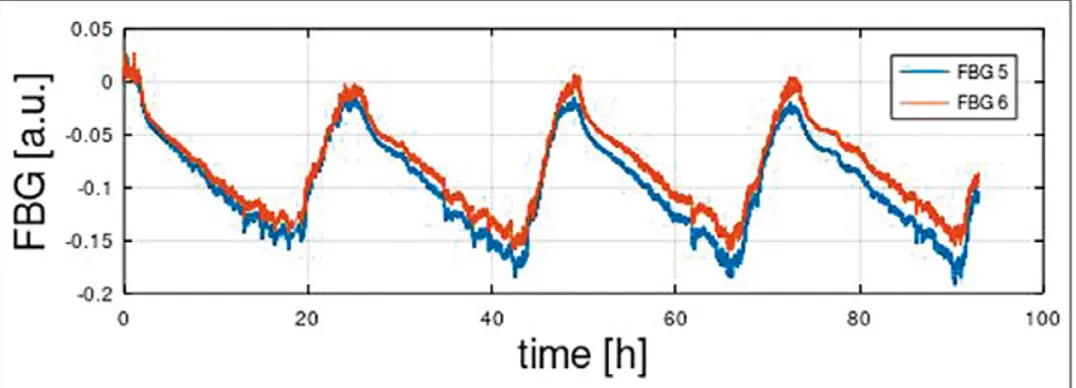STRUCTURAL MONITORING
OF THE NINFEO PONARI BY FIBRE OPTIC SENSORS, PHOTOGRAMMETRY AND LASER SCANNING 1. Introduction
The Ninfeo Ponari is a Roman building located on the slope of the hill of Montecassino, along the road leading to the famous Benedictine Abbey, within the area of the ancient Roman town of Casinum (modern Cassino, Frosinone province, Latium, Italy). It is located within the perimeter of the Natural Monument of Montecassino, entrusted to the Regional Natural Park of the Aurunci Mountains. Until a few decades ago, the parcel of land was owned by the illustrious Cassino family to whom the Ninfeo owes its name. In 1996 it was donated to the University of Cassino.
The building is part of a larger complex, still buried. It consists of a vaulted room (tablinum, oecus) fully opened on one side into a space (atrium) with two opposite side walls only and no ceiling, with a shallow pool in the centre (impluvium); both are richly decorated with wall paintings and floor mosaics. Other parts of the building have been detected, but only partially unearthed and not yet properly analysed. The construction technique is the ancient Roman concrete masonry covered with plaster. The vaulted room is about 4.63×7.43 m2 and reaches a height of approx. 4.58 m up to the top of
the vault; the atrium is about 6.35×7.55 m2 and preserves the side walls up
to a height of approx. 3.50 m. The wall paintings cover about 120 m2 and
the mosaic paving has a surface of about 70 m2. It was probably a summer
dining complex (coenatio aestiva), maybe enriched by fountains (hence the conventional name nymphaeum, after the typical grottoes connected with the cult of the Nymphs), and belonged to a luxurious private domus.
The residence was built around the middle of the 1st century BC
ex-ploiting a pre-existing terrace in polygonal masonry. It was then restored and redecorated either during the 1st or at the beginning of the 2nd century
AD, as suggested by the structural and decorative features. The quality of the decorations makes it one of the most valuable examples of private urban construction in central and southern Italy, comparable to those of Rome and the Vesuvian area.
The splendid domus, perhaps the one inhabited by the senatorial family of the Ummidii Quadrati, originally from Casinum, is part of one of the richest Roman archaeological contexts in southern Lazio, which includes at close range a theatre, an amphitheatre, a spectacular mausoleum, and a national archaeological museum of considerable wealth (Ghini et al. 1995); with its
exquisite quality it also allows to imagine, and in some way to replace the other large Casinum residence, unfortunately lost: the villa which belonged to the great writer Varro, who lived in the time of Caesar, whom he describes in a famous passage of its literary essay on agriculture (Varro, Rust. 3.5.9-17); with its water features and its aviary, the villa of Varro has become an ideal model for the leading architects of the Renaissance.
Until the end of last century, the building was almost completely filled with earth (Valenti 1992). The actual situation is the result of a first exca-vation and restoration (1998-2001) and of later minor interventions. The then Superintendence for the Archaeological Heritage of Lazio conducted the first excavation, restoration and fitting out operation, completed in 2001. Several interventions by the Superintendence were then carried out until 2014 (Betori 2009; Betori et al. 2009, 2018). However, the archaeological site arrangement and the artificial covering of the structure have shown serious shortcomings over time. The lack of isolation from the hillside puts the build-ing under constant pressure, no longer counterbalanced by the fillbuild-ing of the interior, now removed. The walls have remained in direct contact with the ground, thus favouring the infiltration of moisture in the absence of a system of drainage upstream of the structure itself. The modern roofing has revealed to be of insufficient width, limiting itself to covering the bulk of the old build-ing and thus endbuild-ing up channellbuild-ing part of the water drain to the outside of the walls. Painting and mosaic surfaces are affected by serious phenomena of detachment and degradation. Over the years, new lesions and clear signs of failure of statically important parts of the monument came to light.
In 2018, the University of Cassino responded to a call for proposals from the Lazio Region for “Research and Development of Technologies for the En-hancement of Cultural Heritage”. A working group produced a project entitled “The pleasures of water”, in collaboration with the Superintendence. It is recent news that the project is among the winners and will therefore be funded. The recovery and conservation of this monument of exceptional quality, though, is not an undertaking to be faced with a light heart: restoring and consolidating a Roman building without distorting the structural characteristics that have allowed it to be preserved until now is a great challenge of modern archaeology. Both environmental and hydro-geological impact analyses must be carried out; diagnostic analyses must also be carried out on the structures and decorations in order to identify the best strategies for recovery and conservation.
Hence, the University of Cassino has asked ENEA to develop a collab-oration aimed at creating a protocol of cognitive interventions and a system for the permanent structural health monitoring of the building. The collab-oration has started with ENEA working in the framework of the ADAMO (technologies of Analysis, DiAgnostics, and MOnitoring for the conservation and restoration of cultural heritage) project financed by the Lazio Region.
2. Method and results
In order to control the evolution of the state of damage of the Ninfeo Ponari, the Structural Health Monitoring (SHM) intervention has been planned with combined use of: Structure from Motion (SfM) photogram-metry; Electronic Distance Measurement (EDM) robotised survey; array of crackmeters based on Fibre Bragg Grating (FBG) technology. The actual status of Ninfeo Ponari, as stated above, is the result of various excavation and restoration works which occurred in past years since long. No clear technical documentation is available for most of them. Two major past works shall be mentioned: consolidation of the vault by tendon/mortar injection; underpinning of the wall along one side of the atrium with foundation piles. Evidence of possible structural issues can be easily seen by visual inspection. In the tablinum, many cracks characterized by different length, depth and width are present on both the walls and the vault surface; major cracks extend along most of the junction between the vault and the walls. The walls of the atrium are out of the vertical plane with major curvature in the upper part. Parts of the floor have irregular elevation.
In the whole, visual inspection suggests that possible structural issues arise from the interaction of wall and vault with the surrounding soil. The pressure regime on the masonry structure is expected to change upon a temporary imbibition, or eventual saturation, of the soil pores and/or due to an alteration of the equilibrium on the soil mass produced by natural or anthropic factors. Whatever the reason, the interpretation of the mechanisms, the assessment of the present static conditions and the choice of possible restoration strategies require a comprehensive and detailed reconstruction of the kinematics of all structural components. The continuous monitoring is also necessary to promptly highlight ongoing modifications of the stress regime and address mitigating solutions. Moreover, the monitoring activity represents a valid support for developing reliable numerical models able to provide additional information particularly in terms of stress distribution and local failure modes.
2.1 Structure from Motion (SfM)
The planned SHM was intended to start with a photographic survey of the cracks on the full surface of Ninfeo Ponari, to have a reference and to monitor progress of existing crack patterns and appearance of new ones. The experimental campaigns will be periodically repeated over the time to put in evidence structural differences and consequently to plan protection and con-servation measures. The availability of the SfM technique among the authors, suggested to proceed with the survey adopting the necessary procedure. We here briefly recall that SfM allows to obtain a 3D model under the form of
points cloud or polygonal model (mesh), starting from the acquisition of 2D images, that can be post-processed using specific photogrammetric software, based on computer vision methods (a comprehensive presentation of SfM is given in McCarthy 2014).
Fig. 1 – The 3D model of the Ninfeo Ponari.
Pictures were shoot by a dedicated system (3DEYE, by MicroGeo) that integrates a 24 MPX camera mounted on a telescopic monopod with remotely controlled active gimbal mount. Thanks to the ENEA CRESCO (Compu-tational Research Centre for Complex Systems) facility (Ponti 2014), 703 pictures of 9 MB each were processed and fully aligned by Photoscan Pro v. 1.2.6 for real scaled 3D reconstruction. As a final result, the reference scaled 3D model with a dense point cloud of 54951276 points of Ninfeo Ponari with the existing crack patterns was obtained. Fig. 1 shows a view of the scaled 3D reconstruction and Fig. 2 shows one major crack pattern. It shall be noted that the scaled 3D reconstruction can also be used as a reference for features other than cracks, such as mould spots, tile and plaster detachment, qualitative colour deterioration/fading and humidity spots (Mongelli et al. 2018a, 2018b).
2.2 Electronic Displacement Measurement (EDM)
SHM by topographic techniques was adopted, assuming it is adequate to monitor the major/extended structural assessments due to the expected geotechnical mechanism. The adopted technique is the EDM robotised survey, applied on both reflective targets and untreated surface. Measurement is done by robotised total station (Leica Nova TM50) with 0.5” angular accuracy and 2 mm distance accuracy. A total of 9 reflective targets were placed at selected locations on the walls and on the vault. Targets have the shape of balls, they all have equal radius and are used to monitor the relative position of their centres. The shape of the targets allows to point at all of them and from any
position with no variation of the angle of incidence/reflection, thus with no effect on the measurement error. This is important in our application, since targets are used to define the local reference system in the survey of untreated surface, as discussed in the following. Reflective targets provide information about relative displacements of the targeted points (i.e. the macro-elements on which they are fixed to). According to the results which will come from the monitoring work, installation of additional targets will be considered to improve monitoring of macro-elements of the structure.
Survey of untreated surface is done with robotised scanning. Scan of the full surface is done with a large number of robotised small-surface scansions, progressively moving the total station to have each scansion with quasi- perpendicular incidence angle, thus achieving the best working condition. For each scansion, the position of the total station is evaluated with respect to the 9 reflective targets, thus working out a cloud of points of the whole building. The cloud of points is processed to retrieve a polygonal 3D mesh. In processing, smoothing is done to filter minor local effects (surface roughness, cracks, tile/plaster detachments, etc.) which are of no interest with respect to the macro-deformations induced by the geotechnical mechanism. Most interest focuses on the vertical sections parallel to the bottom wall, which are of maximum precision as all the points used to work out each of them come from the same robotic scanning. Fig. 3 shows the full cloud of points. Fig. 4 shows an example of the result of the fit procedure: dots are EDM data from
part of the vault at a section along the X axis (Y-Z vertical plane); full line is the fitted spline.
2.3 Fiber Bragg Grating (FBG)
Crackmeters based on FBG technology (Hill et al. 1997) were installed to monitor selected cracks. We briefly recall that an FBG sensor is a short piece of optical fibre where a diffraction grating has been produced. If broad-band light is launched into the fibre, at the FBG sensor a narrowbroad-band light is back reflected: the peak wavelength of the back reflected light is related to the strain and temperature experienced by the FBG sensor. Thus, strain and temperature can be measured by spectroscopy, typically using two companion FBG sensors to disentangle strain and temperature. This procedure finds easy application in SHM and was already adopted by the authors (Caponero et al. 2019). A custom array of FBG sensors was installed on selected major cracks; the array is intended to be expanded according to the results which will come from the EDM/SfM monitoring work.
Fig. 5 shows two of the installed FBGs. The crackmeters were produced, calibrated and connected in series at the ENEA Research Centre of Frasca-ti. Crackmeters where produced with built-in temperature compensation capability, that is, in each crackmeter two FBGs are present: one FBG is in structural contact with the active component of the crackmeter, and thus it
Fig. 6 – Time history of two crackmeters placed at different locations along one major crack. senses both temperature and strain; the other FBG is in thermal contact only with the active component of the crackmeter; strain is evaluated by differ-ential measurement of the signal of the two FBGs; the measure of the crack opening is encoded in the strain evaluation (variation of the crack opening modifies the strain of the active component of the crackmeter). Up to the date of the submission of this paper, crackmeters were installed but no long term monitoring was done yet. After installation, crackmeters were tested with a four-days long continuous acquisition, expected to point out the effect of the circadian thermal excitation. As an example of the result of the test, Fig. 6 shows the time history of two crackmeters placed along the same crack, with evidence of the circadian cycle of the opening of the crack at the two monitored locations.
3. Discussion of results
Up to the date of submission of this paper, the SHM activity was planned and started with the installation of the array of the FBG sensors and the first/reference survey by EDM and SfM. Results from FBGs are not yet significant because of the short time history. Results from both EDM and SfM show to be coherent and have provided precise information in terms of the overall geometry and the crack patterns. Both these informa-tion play a key role in defining numerical models able to predict stress and strain states and the possible occurrence of failure modes involving parts of the structures. To this purpose the authors are developing a finite ele-ment model which include some of the features emerged by the first phase of the monitoring activity such as the out-of-plane of some elements and the presence of the niches of the walls in the tablinum. Refinement of the model will be allowed in short future by time history of FBG continuous
monitoring, which will provide information about crack movements after rainfalls and circadian/seasonal thermal cycles. The results of the numerical analyses will be analysed together with those of the monitoring in order to better understand the structural health of the monument and define the future actions to be implemented. Moreover, relying on the high capacity of the CRESCO facility, custom software tools are being developed to work out combined analysis of data from EDM and SfM.
4. Conclusions
We presented the work and the results of the launch of a SHM activity based on the combined use of FBG, EDM and SfM. The monitoring strategy is based on a strict integration of the results from the three technologies, which will mutually provide hints to improve the implementation of each of them (EDM/SfM areal resolution at selected surface parts; installation of additional FBG crackmeters; etc.). Monitoring, planned in the long term on repeated EDM/SfM surveys and continuous FBG acquisition, will allow the definition of a strongly validated model for numerical analysis and the definition of best actions to guarantee the structural preservation of the Ninfeo Ponari.
Michele Arturo Caponero, Marialuisa Mongelli
ENEA, Roma
[email protected], [email protected]
Maura Imbimbo, Giuseppe Modoni, Eugenio Polito
Università degli Studi di Cassino e del Lazio Meridionale [email protected], [email protected], [email protected]
Ernesto Grande
Università Guglielmo Marconi, Roma [email protected] REFERENCES
Betori A. 2009, Cassino, novità dal Ninfeo Ponari. Le pavimentazioni dell’atrio, in C. Angelini (ed.), Atti del XIV Colloquio dell’Associazione Italiana per lo Studio e la Conservazione
del Mosaico (AISCOM) (Spoleto 2008), Tivoli, Edizioni Scripta, 195-199.
Betori A., Tanzilli S., Valenti M. 2009, Il Ninfeo Ponari di Cassino: nuove acquisizioni e
prospettive di valorizzazione, in G. Ghini (ed.), Lazio e Sabina 5. Quinto Incontro di Studi sul Lazio e la Sabina (Roma 2007), Roma, “L’Erma” di Bretschneider, 483-498.
Betori A., Vincenti V. 2018, Nuovi pavimenti dalla Domus del Ninfeo Ponari di Cassino, in Atti del XXIII Colloquio dell’Associazione Italiana per lo Studio e la Conservazione
del Mosaico (AISCOM) (Narni 2017), Roma, Quasar, 447-459.
Caponero M.A, Dell’Erba D., Kropp C. 2019, Use of fibre optic sensors for structural
monitoring of temporary emergency reinforcements of the church S. Maria delle Grazie in Accumoli, «Journal of Civil Structural Health Monitoring», 9, 353-360.
Ghini G., Valenti M. 1995, Cassino. Museo e Area Archeologica, Roma, Istituto Poligrafico dello Stato.
Hill K.O., Meltz G. 1997, Fiber bragg grating technology fundamentals and overview, «Journal of Lightwave Technology», 15, 1263-1276.
McCarthy J. 2014, Multi-image photogrammetry as a practical tool for cultural heritage
survey and community engagement, «Journal of Archeological Science», 43, 175-185.
Mongelli M. et al. 2018a, 3D photogrammetric reconstruction by drone scanning for FE
analysis and crack pattern mapping of the Bridge of the Towers in Spoleto, in Proceedings of the 5th International Conference on Mechanics of Masonry Structures Strengthened
with Composite Materials (Bologna 2018), «Key Engineering Materials», 747, 423-430.
Mongelli M. et al. 2018b, Structure-from-Motion technique in the Catacombs of Priscilla
in Rome. Improvements in the conservation, the safety and the fruition, «Kermes
Ap-plications of 3D Technology in Cultural Heritage», 107, 111-116.
Ponti G. et al. 2014, The role of medium size facilities in the HPC ecosystem: The case of the
new CRESCO4 cluster integrated in the ENEAGRID infrastructure, in Proceedings of the International Conference on High Performance Computing and Simulation HPCS 2014 (Bologna 2014), 1030-1033 (https://doi.org/10.1109/HPCSim.2014.6903807).
Valenti M. 1992, Il “ninfeo Ponari” di Cassino (FR): analisi stilistica e cronologica delle
decorazioni, «Archeologia Classica», 64, 51-80.
ABSTRACT
The Ninfeo Ponari is an ancient building dating back to the first century BC as part of a rich domus, located in the ancient Roman city of Casinum. It consists of two bodies: a rectangular room covered by a barrel vault and an atrium with no roof with a shallow pool in the middle, both paved with mosaics and decorated with wall paintings. The structural condition of the building is critical and its preservation is at risk, as it is located on a hill slope where some substantial sliding activity is occurring. Moreover, it is not protected by an efficient rainfall drainage system. Aim of this paper is to illustrate the strategies and the digital tech-niques recently applied to initiate a permanent monitoring of the building structural condition.




